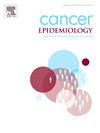The relationship of occupational and recreational solar ultraviolet radiation with the risk of prostate cancer: A Canadian cohort study
IF 2.3
3区 医学
Q3 ONCOLOGY
引用次数: 0
Abstract
Background
The objective of this study was to examine the relationship of recreational and occupational exposure to solar ultraviolet radiation (UVR) with the risk of developing prostate cancer (PC).
Methods
Data from three provincial prospective cohorts in Canada (Ontario Health Study, Québec’s CARTaGENE, and Alberta’s Tomorrow Project) were used. A nested case-cohort approach was applied for the examination of occupational solar UVR and was based on longest held job at baseline. Cox proportional hazards models with age as the time-scale were used to estimate the risk of PC associated with self-reported time spent in the sun and occupational solar UVR (weighted model). Effect modification by body mass index (BMI) was explored.
Results
A total of 543 PC cases were included in the analysis of time spent in the sun and 1667 PC cases were included in the analysis of occupational solar UVR. Compared to < 1 h/day in the sun, 1-< 2 h (Hazard Ratio [HR] 0.96, 95 % CI: 0.81–1.13) and ≥ 2 h (HR 0.89, 95 % CI: 0.76–1.05) were not significantly associated with PC risk. Occupational solar UVR was also not significantly associated with PC risk (HR 1.08, 95 % CI: 0.90–1.30). Compared to < 1 h/day, individuals who spent 1-< 2 h in the sun were at a reduced risk of PC if they had a normal BMI (HR 0.64, 95 % CI: 0.44–0.92), but not if they were overweight (HR 0.99, 95 % CI: 0.76–1.30) or obese (HR 1.20, 95 % CI: 0.90–1.61).
Conclusion
Overall, results do not support an association between solar UVR exposure and PC risk, but larger studies are needed to confirm these findings. There is some indication of effect modification by BMI that should be explored in future studies.
职业和娱乐太阳紫外线辐射与前列腺癌风险的关系:一项加拿大队列研究
本研究的目的是探讨休闲和职业暴露于太阳紫外线辐射(UVR)与患前列腺癌(PC)风险的关系。方法使用来自加拿大三个省前瞻性队列(安大略省健康研究、quacimac 's CARTaGENE和阿尔伯塔省明天项目)的数据。一套嵌套病例队列方法应用于职业太阳紫外线辐射的检查,并以基线最长工作时间为基础。以年龄为时间尺度的Cox比例风险模型用于估计与自我报告的日晒时间和职业太阳紫外线辐射(加权模型)相关的PC风险。探讨了身体质量指数(BMI)对治疗效果的影响。结果共有543例PC被纳入日晒时间分析,1667例PC被纳入职业性太阳紫外线辐射分析。与日晒时的<; 1 h/天相比,1-<; 2 h(风险比[HR] 0.96, 95 % CI: 0.81-1.13)和≥ 2 h(风险比[HR] 0.89, 95 % CI: 0.76-1.05)与PC风险无显著相关。职业太阳紫外线辐射也与PC风险无显著相关(HR 1.08, 95 % CI: 0.90-1.30)。与<; 1 小时/天相比,如果BMI正常(HR 0.64, 95 % CI: 0.44-0.92),在阳光下花费1-<; 2 小时的个体患PC的风险降低,但如果他们超重(HR 0.99, 95 % CI: 0.76-1.30)或肥胖(HR 1.20, 95 % CI: 0.90-1.61)则不然。总的来说,研究结果不支持太阳紫外线照射与PC风险之间的关联,但需要更大规模的研究来证实这些发现。在未来的研究中,有一些迹象表明BMI可以改变疗效。
本文章由计算机程序翻译,如有差异,请以英文原文为准。
求助全文
约1分钟内获得全文
求助全文
来源期刊

Cancer Epidemiology
医学-肿瘤学
CiteScore
4.50
自引率
3.80%
发文量
200
审稿时长
39 days
期刊介绍:
Cancer Epidemiology is dedicated to increasing understanding about cancer causes, prevention and control. The scope of the journal embraces all aspects of cancer epidemiology including:
• Descriptive epidemiology
• Studies of risk factors for disease initiation, development and prognosis
• Screening and early detection
• Prevention and control
• Methodological issues
The journal publishes original research articles (full length and short reports), systematic reviews and meta-analyses, editorials, commentaries and letters to the editor commenting on previously published research.
 求助内容:
求助内容: 应助结果提醒方式:
应助结果提醒方式:


